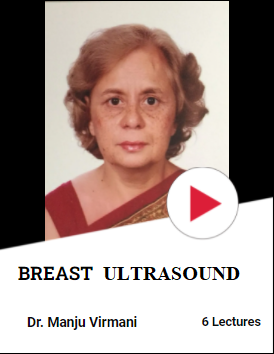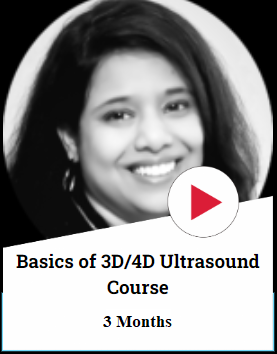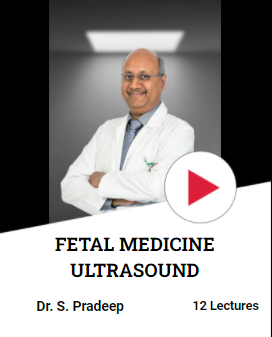Fetal thorax can be well visualized by ultrasound during the second and third trimester. The axial four-chamber view is the fundamental ultrasound plane to assess the heart and lungs. The true axial section is confirmed the symmetric appearance of ribs on either side. Fetal lungs appear as homogeneously echogenic structures on either side of the heart. Both lungs occupy two-thirds of the chest, the rest one-third by the heart. Assessment of the size of the thorax is done by measuring the thoracic circumference and comparison of the thoracic size to the abdomen by the TC/AC ratio. Both domes of the diaphragm are simultaneously visualized in a coronal view of the thorax. The diaphragm is delineated as a hypoechoic curvilinear structure layer below the base of the lung and superior to the fetal liver or stomach. Color Doppler is useful to the pulmonary artery and pulmonary veins. Abnormalities can be in the size of the thorax, the shift of the mediastinum(heart), echogenicity of the lung, or a mass lesion.
CONGENITAL DIAPHRAGMATIC HERNIA
Definition
Congenital diaphragmatic hernia (CDH) is the herniation of abdominal viscera into the fetal thorax due to congenital defects in the fetal diaphragm. The incidence of CDH is estimated to be 1 to 4.5 per 10,000 live births. CDHs are classified according to the site of the defect. CDH occurs most commonly on the left side (75% to 90%), can also occur on the right side (around10%) and bilaterally (less than 5%).
Ultrasound findings
Left sided CDH
- Mediastinal (cardiac) shift to the right is the first clue. The apex of the heart is to the left.
- In most cases, the fluid filled stomach is seen in the left hemithorax. detected in atruly axial four-chamber section of the chest. The absence of the fluid filled stomach in the abdomen should be confirmed. The presence of an intrathoracic cystic structure in the absence of an identifiable stomach in the abdomen is pathognomonic of CDH.
- Together with the stomach, the bowel also herniates commonly into the thorax. Bowel echogenicity is akin to that of the lung. Rarely only small bowels are seen in the hernia and the stomach is seen in the abdomen. When this is suspected, examination with a high-frequency transducer may reveal the typical bowel echo pattern and peristalsis. The superior mesenteric artery of the fetus has a cephalad direction in bowel herniation and may be seen by Color Doppler examination.
- The left lobe of the liver flips up into the thorax adjacent to the heart, perpendicular to the horizontal axis of the rest of the liver. The fetal stomach is displaced by the herniated liver away from the cardia and posteriorly. The herniated liver appears as a homogeneous wedge of soft tissue immediately adjacent to the cardia anteriorly. visualizing the portal vein and left hepatic vein by color Doppler and use of high-frequency transducer aid in determining the presence of liver in the thorax. The presence or absence of liver in the herniation is a prognosticating factor.
- Paradoxical respiratory movement of the herniated contents may be recognized in the coronal sections. The inspiratory descent of the right dome is accompanied by upward movement of the herniated viscera on the affected side. This sign is useful in LDH containing only bowels
- The volume of the abdominal contents is reduced due to the herniation and this is reflected as scaphoid shape of the abdomen and low abdominal circumference.
- Using a high frequency transducer, the posterior discontinuity of the diaphragm may be demonstrated on a parasagittal section.
- Polyhydramnios may be seen due to pressure on the esophagus or kinking of the gastric outlet. This is most often seen in the third trimester.
- The ipsilateral lung is not seen in most instances due to compression by the herniating contents.
Right-sided CDH
The mediastinal (cardiac) shift to the left is the first clue (Fig.).
Right lobe of liver is displaced upwards into right hemithorax, however similar echogenicity of fetal liver and right lung makes the identification of liver herniation difficult. High-frequency transducers and the use of power or color Doppler to identify the intrahepatic veins in the thorax will help to identify liver herniation. Color Doppler will show displacement of right hepatic vein and altered course of fetal portal vein Fetal gall bladder in right hemithorax may be seen on careful examination.
Differential diagnosis
Diaphragmatic eventration is a congenital anomaly due to incomplete muscularization and of the membranous diaphragm. The diaphragm (total or partial) is fibroelastic in nature and is elevated in eventration. Complete eventration is more common in males and on the left side. The abdominal viscera move up under the elevated diaphragm and mimic the findings in CDH including the mediastinal shift. Presence of the diaphragm prevents total compressionof the ipsilateral lung which may be seen capping the pseudo-herniated contents. The ‘lung cap’ sign may be recognized on ultrasound especially in the parasagittal or coronal sections and can be confirmed on MRI. The intact but elevated diaphragmatic contour may be recognized. The ‘lung cap sign’ is absent in CDH. There may be associated pleural effusion in around half the cases of eventration. Identification of eventration is important as fetuses with even ration have a better outcome.
Left sided CDH should be differentiated from macrocystic type of CPAM as cystic space/s can mimic intrathoracic stomach or bowel. Right-sided CDH should be differentiated from microcystic (solid) CPAM and pulmonary sequestration and right lung hypoplasia. Usually, solid CPAM or pulmonary sequestration is more echogenic than herniated liver.
Associated abnormalities
Associated anomalies are common with CDH and have an important role in prognostication. 40% to 50% of CDH are associated with other anomalies including, chromosomal abnormities, single gene syndromes and other structural anomalies. Prognosis of CDH with associated conditions is poor.
Prognostication
In the absence of any associated conditions or defects, the prognosis of CDH is dependent on the degree of lung hypoplasia and other factors.
- The observed to estimated lung head ratio (O/E LHR): The following are the criteria for measuring the O/E LHR in the case of left CDH (JC Jani). a. True axial four
chamber view is obtained with the right lung oriented closer to the transducer. b. Rib shadowing is avoided by getting the beam through the intercostal space. c. The image is magnified after freezing such that the thorax occupies the whole display area of the monitor. d. The right lung area may be measured either by the two diameter or tracing methods. In the former method, the longest anteroposterior diameter and the widest lateral diameters of the right lung are obtained ensuring that the two lines are orthogonal to each other. The product of the two diameters in mm 2 is the area of the right lung. In the trace method, the outline of the right lung is traced and the area is read off (diagram and Fig.). Care is taken not to include the myocardial thickness into the lung area. The trace method is more reproducible. The area of the right lung in square millimeters is divided by the head circumference in millimeters 3 . The resultant
value is the observed LHR. The expected LHR value for the gestational age is obtained from nomograms. The O/E LHR is then calculated as a percentage. Online calculation resources enable easy computation in practice. O/E LHR must be computed on follow up scans. The prognostication by of left CDH by O/E LHR (surgical repair in 96%) is as in table 1. O/E LHR% Liver down left CDH (isolated)
Tabel 1. Survival rates % for O/E LHR in liver down and liver up left CDH (Kitty G Snoek).
If O/E LHR is lesser than 25% the disease is classified as severe, moderate if 26%-45%
and mild if more than 45%. The ECMO rates in liver up left CDH was double that of
liver down left CDH. 3D ultrasound lung volume prediction may be done but is
technically demanding.

- Liver up left CDH has poorer outcome compared to liver down.
- Detection at an earlier gestational age with larger hernia had poor outcome.
- More the gestational age at delivery better is the outcome.
- Fetuses with CDH whose nuchal translucency was high have a poorer outcome than
those that had a normal measurement.
Fetal therapy
FETO (fetoscopic endoluminal tracheal occlusion) involves the endoscopic insertion of an inflatable balloon into the fetal trachea. The tracheal blockage causes retention of fluid produced by the lungs which stimulate lung growth. The balloon is inserted at 26 weeks of gestation and removed endoscopically at 34 weeks. FETO is considered as an option if O/E LHR is lesser than 25%.
CONGENITAL PULMONARY AIRWAY MALFORMATION
Congenital Pulmonary Airway Malformation (CPAM) is a developmental anomaly characterized by a mass of disorganized terminal bronchi (in communication with the tracheobronchial tree) with a paucity of normal alveolar structures involving a whole lobe (commonly the lower lobe) of the lung. The vascular supply is from the pulmonary circulation. The uninvolved ipsilateral lobe/s are compressed by the lesion and cannot be visualized by ultrasound. The lesion is generally expansive or tumescent resulting in mediastinal shift and diaphragmatic flattening. These are sporadic lesions and are not associated with chromosomal abnormalities or genetic syndromes. 97% of the lesions are unilateral. The incidence is 1 in 4000 live births Ultrasound findings
- On the basis of ultrasound appearance, CPAM is classified as type 1 microcystic, type II mixed or type III microcystic or solid.
- The solid (microcystic) type is seen as a swollen, hyperechoic lung.
- These lesions grow and peak in size by about 26 weeks. They then plateau off. In about 20% of cases the lesion regresses and may even disappear. Hence, serial
ultrasound examinations, at 2 to 3 weekly intervals, are required to quantitate the size of the lesion over time and to recognize hydropic changes if any. Once the size of the lesion stabilizes, the serial monitoring may be done less frequently. Ultrasound disappearance of the lesion implies that the lesion has become isoechoic to the surrounding lung. They may be identified postnatally by CT scan. - The cystic (macrocystic) type is seen as multiple, well defined cysts (few millimetres to over a centimetre in size). A macrocyst is said to be dominant, if it occupies more than one third of the affected lung. The cystic type of CPAM does not regress with advancing gestational age.
- In the mixed type, both solid and cystic regions are seen in the affected lung (lobe).
- On color doppler study the mass is supplied by a branch from pulmonary artery and drained by pulmonary vein.
- Depending on the size, all three types may result in contralateral mediastinal shift
- Compression of the heart by large lung lesions may result in hydrops.
- The quantitative assessment of the lesion is done by the CPAM volume ratio (CVR). It is the product of the length, width, depth and 0.52 divided by the head
circumference. All parameters are measured in centimetres. - Polyhydramnios due to raised intrathoracic pressure and esophageal compression may occur in the third trimester.
Differential diagnosis
BPS is differentiated from a solid type of CPAM by the presence of a direct arterial supply to the lesion from the descending aorta.
Prognostication
The only prognostic factor which identifies foetuses with high risk of prenatal demise is the occurrence of hydrops Fetal hydrops is seen in less than 10% of cases at diagnosis, although it can develop in another 30% of cases during follow-up. Risk of occurance of hydrops is assessed by mass volume head ratio (MVR). A MVR of more 1.6 predicts 80% risk of fetal hydrops, while a ratio <1.6 is associated risk of hydrops lesser than 3%.
Fetal therapy
- Large macrocyst/s may be aspirated under ultrasound guidance. Earlier in gestational age thoraco-amniotic shunting may be beneficial to reduce the mediastinal shift and ameliorate hydrops.
- Large solid CPAMs with a CVR of more than 1.6, after 26 weeks, may be treated by maternal IM injection of 12 mg betamethasone repeated after 24 to 48 hours. This may promote regression and prevent hydrops BRONCHOPULMONARY SEQUESTRATION Bronchopulmonary sequestration (BPS) represents a developmental mass of non-functioning pulmonary tissue that fails to communicate with tracheobronchial tree and receives arterial supply from the systemic circulation, which is pathognomonic for this condition. Two subtypes of pulmonary sequestration, extralobar (25% of cases) and intralobar (75% of cases)
are defined. Extralobar pulmonary sequestration consists of a discrete accessory mass that has its own pleural covering. The arterial supply for both extralobar and intralobar BPS is through an anomalous artery directly arising from descending thoracic or abdominal aorta. The venous drainage in extralobar BPS is to the systemic circulation through azygos, hemiazygos or superior vena cava into right atrium. The venous drainage of intralobar BPS is through the pulmonary vein into the left atrium. Extralobar BPS occurs mostly in the left lung basally. Rarely, extralobar BPS may occur below the diaphragm. Subdiaphragmatic BPS are
asymptomatic and not associated with hydrothorax.
Ultrasound findings - BPS is seen as a well-defined echogenic wedge shaped or triangular mass lesion in the basal region of the lung, more on left side.
- The size of the lesion may vary. Large lesions may cause mediastinal shift and hydrops. Most lesions are small or moderate in size.
- Color Doppler visualisation of a systemic artery arising from thoracic or abdominal aorta (seen in the coronal or axial plane) feeding the mass is diagnostic of BPS. The venous drainage is to systemic vein in Extralobar BPS and pulmonary vein in Intralobar BPS.
- Sagittal sections are necessary to assess the caudal extension of the mass, and to place it above or below the diaphragm.
- Ipsilateral hydrothorax (due to torsion of vascular pedicle or leakage from dilated lymphatics in the lesion) occurs approximately in 5% to 10% of extralobar BPS. As presence of hydrothorax is never seen in CPAM, Presence of this finding is very suggestive the diagnosis of BPS. Hydrothorax adds to the mass effect of the lesion and predisposes to hydrops.
- Subdiaphragmatic extralobar pulmonary sequestration is seen as a retroperitoneal hyperechoic solid mass classically in the region of the left adrenal gland. The
systemic arterial supply confirms the diagnosis.
Differential diagnosis
BPS should be considered in any fetus with a solid chest mass, especially if the mass is wedge shaped and is in the left lower thorax. Other conditions to be considered in differential diagnosis are CPAM, lobar emphysema and bronchial atresia resulting in an obstructed and distended lobe. Triangular shape and the presence of feeding artery from descending aorta confirm BPS.
Prognostication
The tendency to regress and even disappear during third trimester has been reported. The prognosis of BPS is mainly related to the presence of secondary effects like pulmonary hypoplasia or hydrops. Association of BPS with hydrops carries a dismal prognosis. BPS with pleural effusion has a poor neonatal outcome due to pulmonary hypoplasia. Risk of hydrops is assessed by MVR similar to CPAM.
Fetal therapy
Large pleural effusions associated with PS may be drained by thoracocentesis or thoraco amniotic shunting. Occlusion of feeding artery by laser ablation, radio frequency ablation, thrombogenic coil embolisation or injection of sclerosant into the feeding vessel at the hilus of the lesion have been reported with regression of the lesion. CONGENITAL HIGH AIRWAY OBSTRUCTION SYNDROME Congenital High Airway Obstruction Syndrome (CHAOS) is a developmental condition resulting from atresia or stenosis of a segment of upper airways at the level of trachea or larynx. This is mostly a sporadic condition.
Ultrasound findings
- The abnormality may be detected as early as 16 weeks of gestation.
- In four chamber view, both lungs are symmetrically enlarged, echogenic and homogeneous. The tumescent, hyperplastic lungs cause the diaphragm to be flattenedor inverted.
- The heart is displaced anteriorly in midline (mesocardia) and appear squeezed by distended lungs (MICROCARDIA).
- Fluid distended trachea and bronchi may be visualised in the coronal view. This is termed the fluid bronchogram.
- Fetal ascites is universal.
- Polyhydramnios due to oesophageal compression by the enlarged lungs is seen.
Differential diagnosis
Bilateral solid (microcystic) type of CPAM be considered in differential diagnosis. The tumescence of the lungs is much lesser in bilateral CPAM and the fluid filled trachea and bronchi are not seen.
Associated abnormalities
More than 50% of fetuses with CHAOS have associated anomalies, most commonly renal, central nervous system malformations and tracheoesophageal atresia. Tracheal or laryngeal atresia, bilateral renal agenesis, microphthalmia, syndactyly or polydactyly, facial cleft and congenital heart disease are seen in the autosomal recessive Fraser syndrome. CHAOS is not associated with chromosomal abnormalities.
Prognostication
CHAOS is a uniformly lethal condition,
BRONCHOGENIC CYST
Bronchogenic cysts are considered bronchopulmonary foregut anomalies. They arise due to abnormal budding of the tracheobronchial tree and the primitive foregut, in many cases as accessory lung buds of the ventral diverticulum of the foregut.
Ultrasound findings
- Fluid-filled cyst in the fetal mediastinum, especially near the carina, seen in four-chamber view, should raise the suspicion of bronchogenic cyst.
- The fluid may contain echogenic debris.
- Bronchogenic cysts may be tiny (few mm diameter) to very large (more than 5cm diameter). The very small cyst may be difficult to detect by antenatal ultrasound, but the pressure effect on the bronchus in the form of a unilateral tumescent hyperechoic lung is more evident. Unilateral enlarged fetal lung should prompt a careful search for the bronchogenic cyst at the hilum of the lung.
- Intrapulmonary bronchogenic cysts are centrally situated in the lung.
Differential diagnosis
Intrathoracic cystic lesions as, cystic CPAM, neurenteric cyst, esophageal duplication cyst, or intrathoracic stomach in CDH may be considered in the differential diagnosis. Echogenic lung tissue surrounding the cyst of CPAM helps to differentiate from the bronchogenic cyst. Identification of the stomach in its normal location rules out CDH. A neurenteric cyst is associated with spinal lesions and is located in the posterior mediastinum. A unilateral enlarged, echogenic lung due to bronchial obstruction may be caused by bronchial atresia or congenital lobar emphysema, apart from the bronchogenic cyst. Fetal MRI will be useful for further evaluation of the anatomy.
LUNG AGENESIS-APLASIA-HYPOPLASIA
Lung agenesis is absence of one or both lungs that results from failure of one or both lungs. This due to failure of a bronchial bud or buds to develop. Absent lung is associated with absence of the pulmonary and vein. Bilateral pulmonary agenesis is rare and is incompatible with life. Unilateral pulmonary agenesis is less rare and is compatible with life. They are sporadic anomalies.
Lung hypoplasia is developmental in origin and presents as a small sized lung. Right lung hypoplasia may be associated with partial anomalous venous drainage into the IVC. This is termed Scimitar syndrome.Secondary pulmonary hypoplasia is due to intrathoracic space occupying lesions causing
compression (CDH, CPAM, BPS), lack of normal growth of thoracic bony cage (lethal skeletal dysplasias), lack of amniotic fluid (bilateral renal agenesis, bladder outletobstruction, premature rupture of membranes, placental insufficiency) or lack of fetal breathing movements (arthrogryposis).
Ultrasound findings
- On the four-chamber view, the heart is totally shifted to one side with the lung on that side absent. The cardia is in contact with the ipsilateral chest wall. The contralateral lung is normal in echogenicity but may be hypertrophied.
- The abdominal (situs) arrangement of the organs is normal.
- The pulmonary artery and veins on the side of lung absence are not seen on color Doppler study. The cardiac connections are otherwise normal.
- The ipsilateral dome of diaphragm may be elevated.
- In unilateral lung hypoplasia, there is a cardiac shift to the ipsilateral side. Cardiac connections are normal. In right lung hypoplasia, the cardia is shifted to the right side with the apex becoming substernal in location. It may mimic myocardia. One has to rule out any space-occupying lesion in the left hemithorax. With venous color Doppler settings, the anomalous infra diaphragmatic right pulmonary vein should be sought for in the sagittal plane. Presence of the anomalous pulmonary vein transgressing the diaphragm confirms Scimitar syndrome.
- Fetal MRI may be of additional use to differentiate bilateral pulmonary agenesis from other congenital anomalies of the thoracic cage. Associated anomalies Right lung aplasia is frequently associated with other congenital anomalies in cardiovascular, gastrointestinal, genitourinary and skeletal systems. Left lung aplasia is most often isolated.
Prognosis
Bilateral lung agenesis is incompatible with postnatal life. Prognosis is worse for right than left lung agenesis probably because of a greater degree of associated anomalies.
Obstetric management
Fetal karyotyping is not necessary as there is no association with chromosomal abnormalities. Induction of labour aiming at vaginal delivery in hospital with neonatal intensive case and pediatric surgery is recommended. Early neonatal intubation may be needed in rare cases of lung agenesis, due to tracheal malposition. Simitar syndrome does not need special neonatal care.
BRONCHIAL ATRESIA
Congenital bronchial atresia is a developmental anomaly in which a segmental bronchus does not communicate with the central airway.
Ultrasound findings
Although bronchial atresia has been reported to be the second most common congenital tracheobronchial malformation, this lesion has only been rarely diagnosed prenatally. In normal fetus, the bronchi are not visualised. A main stem or segmental bronchus may be visualised by ultrasound due to its fluid filled content distal to the atresia. The obstructed lung segment or lobe is enlarged and echogenic. Atresia of main stem bronchus may present as enlarged echogenic lung with dilated bronchial tree resulting in a mediastinal shift to the contralateral side.
Differential diagnosis
CPAM and BPS are the differential diagnosis.
Obstetric management
Serial ultrasound examination every four weeks to monitor the evolution of the condition is recommended. In proximal bronchial atresia, delivery by Caesarean section is indicated because of the need for immediate postnatal resuscitation and intubation. Invasive testing for fetal karyotyping is not indicated as there is no association with aneuploidy.
Prognosis
Presence of ascites (resulting from central venous compression) is a bad prognostic factor.
CONGENITAL LOBAR OVERINFLATION
Congenital lobar overinflation is lobar over inflation of the lung without destruction of alveolar septa. It is also referred as congenital lobar emphysema.
Etiopathogenesis
CLO is due to anomalous development of a lobar or segmental bronchus. It may also be due to intrinsic (deficient cartilage or dysplasia) or extrinsic bronchial obstruction. Usually upper lobes or right middle lobe is involved.
Ultrasound findings
CLO has an appearance similar to that of solid type of CPAM (echogenic tumescent lung mass). SOMETIMES it IS ISOECHOIC TO LUNG, WHEN THE CLUE IS ONLy MEDIASTINAL SHIFT TO opposite side. Hypervascularity may be seen on color Doppler.
Differential diagnosis
Solid CPAM, BPS and bronchial atresia are the differential diagnoses. Hypervascularity in the lesion may be able to distinguish CLE from the other lesions.
NEURENTERIC CYST
Neuroenteric cysts are thought to result from incomplete separation of the notochord from the foregut in the third week of embryogenesis before the closure of the neural tube. Neuroenteric cysts occur in the posterior mediastinum immediately anterior to the spine extending into the vertebral canal.
Ultrasound findings
- The typical appearance is of a septated or bilobed cystic mass in the posterior mediastinum.
- The cyst may extend through a vertebral defect into the vertebral canal, Vertebral anomalies (hemivertebrae, butterfly or clefted vertebral body, absent or
fused vertebrae and diastematomyelia) at the level of the cyst are present.
Associated anomalies
Associated anomalies include cloacal or bladder extrophy, renal agenesis and intestinalanomalies such as imperforate anus, duplication cyst and malrotation. Large cysts may have a
poor outcome. Outcome also depends on the severity of the vertebral and spinal cord lesions
FETAL HYDROTHORAX
Fetal hydrothorax is accumulation of fluid in the pleural space (pleural effusion). It may be unilateral or bilateral and is said to be primary if it is isolated and not a part of fetal hydrops. Pleural effusion which occurs as a part of fetal hydrops is termed secondary and is usually bilateral. The incidence of primary hydrothorax is 1 in 10000 to 1 in 15000.
Etiopathogenesis
Primary hydrothorax is chylous in origin (chylothorax) and may be due to atresia, fistula or absence of thoracic duct or rarely pulmonary lymphangiectasia. In its isolated form without any associated anomalies, it is a sporadic occurrence and is not related to chromosomal or genetic conditions. Secondary hydrothorax could be in the context of immune or non-immune hydrops. Non immune hydrops could be due to chromosomal abnormality, infection, tumor, cardiac defects and syndromes.
Ultrasound findings
- In four chamber cardiac view, pleural fluid is seen as a crescent shaped region of fluid in the thorax, surrounding the fetal lung. The fluid is anechoic indicating clear fluid.
- A unilateral pleural effusion is said to be hypertensive if it causes a mediastinal shift to the opposite side and flattening of the diaphragmatic dome. Unilateral hydrothorax is usually primary (chylothorax). A unilateral hypertensive hydrothorax may result in hydrops fetalis due to the pressure on the cardia. In such instances, hydrothorax can develop on the contralateral side. The resultant bilateral hydrothorax is asymmetric reflecting the mediastinal shift.
- Hydrothorax or chylothorax can regress in about 10% to 20% of cases. In some cases the pleural may disappear with needle aspiration.
- Fetal hydrothorax is rarely detected before 15 weeks, except in Down or Turner syndromes.
- Bilateral hydrothorax when scanned from the posterior aspect, typically show the bat’s wing appearance of the lungs.
- Gross pericardial effusion can be differentiated from bilateral hydrothorax as fluid does not extend lateral to go around the lungs.
Associated abnormalities
Risk of chromosomal abnormalities is high. Trisomy 21 and monosomy X are found in 10% of cases of the secondary forms.
Prognostication
Prognosis for isolated primary hydrothorax depends on whether it is hypertensive causing pulmonary hypoplasia or hydrops or not. If so, thoracoamniotic shunting helps to relieve introthoracic pressure and promote lung development. It is prudent to rule out aneuploidy to establish the ‘primary’ nature of the condition. Pleural effusions associated with non-immune hydrops or chromosomal abnormality have poor outcomes. The outcome is also poor when associated with other congenital anomalies such as congenital heart disease and central nervous system anomalies.
Obstetric management
Detailed fetal echocardiography and middle cerebral artery peak systolic is recommended in addition to the anomaly assessment. Fetal karyotyping and DNA testing is planned. Specific syndromes such as Noonan syndrome (and other conditions as inborn errors of metabolism) should be considered and discussed with the geneticist. Maternal serum testing for infection is indicated. If the hydrothorax is small, follow-up examinations to look for progression or regression is planned. If the hydrothorax resolves spontaneously, no invasive therapy is required. If the hydrothorax is very large or increases over time with signs of deterioration (i.e., hydrops) fetal thoracocentesis by ultrasound guided needle aspiration or thoracoamniotic shunt should be considered. Hydropic changes regress when the effusion is decompressed. An alternative to shunting is pleurodesis in with a sclerosant substance is injected in the pleural cavity.
Postnatal management In many cases of congenital hydrothorax, resolution of the effusion occurs spontaneously with time, probably because collateral lymphatic channels develop. Delivery should be planned in a tertiary care center. In cases of respiratory distress, chest tube drainage and ventilation may be necessary. If drainage remains persistent and copious, surgery consisting of ligation of the thoracic duct may be necessary. No treatment is possible for idiopathic non-immune hydrops fetalis.












